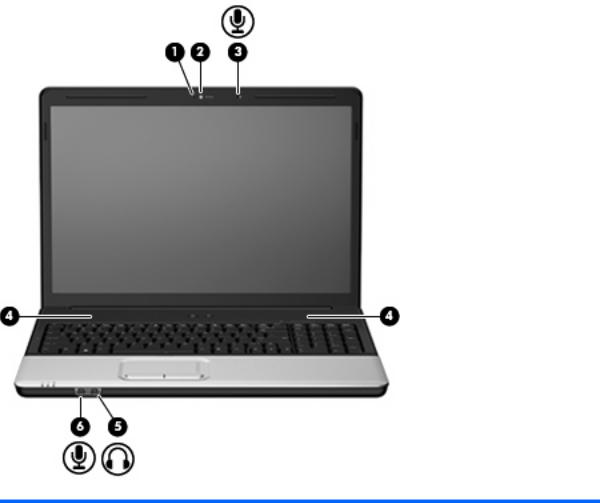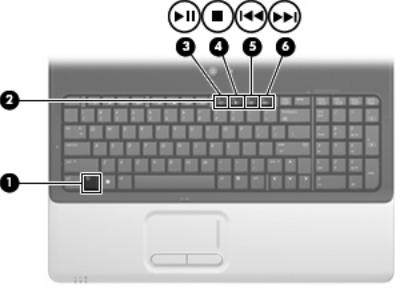HP G60-630US, G60, CQ60, CQ615DX User Manual
Multimedia
User Guide
© Copyright 2009 Hewlett-Packard
Development Company, L.P.
Windows is a U.S. registered trademark of Microsoft Corporation.
The information contained herein is subject to change without notice. The only warranties for HP products and services are set forth in the express warranty statements accompanying such products and services. Nothing herein should be construed as constituting an additional warranty. HP shall not be liable for technical or editorial errors or omissions contained herein.
First Edition: August 2009
Document Part Number: 573756-001
Product notice
This user guide describes features that are common to most models. Some features may not be available on your computer.

Table of contents
1 |
Multimedia features |
|
|
Identifying your multimedia components .............................................................................................. |
2 |
|
Adjusting the volume ............................................................................................................................ |
3 |
|
Using the media activity functions ........................................................................................................ |
4 |
|
Using the media activity hotkeys ......................................................................................... |
4 |
2 Multimedia software |
|
|
|
Using DVD Play software ..................................................................................................................... |
5 |
|
Using other preinstalled multimedia software ....................................................................................... |
5 |
|
Installing multimedia software from a disc ............................................................................................ |
5 |
3 Audio |
|
|
|
Connecting external audio devices ...................................................................................................... |
6 |
|
Checking your audio functions ............................................................................................................. |
6 |
4 Video |
|
|
|
Connecting an external monitor or projector ........................................................................................ |
8 |
|
Connecting an HDMI device (select models only) ................................................................................ |
9 |
|
Configuring audio for HDMI (select models only) ................................................................ |
9 |
5 |
Optical drive |
|
|
Identifying the installed optical drive ................................................................................................... |
11 |
|
Using optical discs .............................................................................................................................. |
12 |
|
Selecting the right disc ....................................................................................................................... |
13 |
|
CD-R discs ......................................................................................................................... |
13 |
|
CD-RW discs ..................................................................................................................... |
13 |
|
DVD±R discs ..................................................................................................................... |
13 |
|
DVD±RW discs .................................................................................................................. |
13 |
|
LightScribe DVD+R discs .................................................................................................. |
13 |
|
Blu-ray discs ...................................................................................................................... |
14 |
|
Playing music ..................................................................................................................................... |
15 |
|
Watching a movie ............................................................................................................................... |
16 |
|
Changing DVD region settings ........................................................................................................... |
17 |
|
Creating or “burning” a CD or DVD .................................................................................................... |
18 |
|
Removing an optical disc (CD or DVD) .............................................................................................. |
19 |
6 Webcam (select models only) |
|
|
|
Webcam tips ....................................................................................................................................... |
21 |
iii
Adjusting webcam properties ............................................................................................................. |
21 |
7 Troubleshooting |
|
The optical disc tray does not open for removal of a CD or DVD ....................................................... |
22 |
The computer does not detect the optical drive ................................................................................. |
23 |
A disc does not play ........................................................................................................................... |
23 |
A disc does not play automatically ..................................................................................................... |
24 |
A DVD movie stops, skips, or plays erratically ................................................................................... |
24 |
A DVD movie is not visible on an external display ............................................................................. |
25 |
The process of burning a disc does not begin, or it stops before completion .................................... |
25 |
A device driver must be reinstalled .................................................................................................... |
25 |
Obtaining the latest HP device drivers ............................................................................... |
26 |
Obtaining the latest Windows device drivers ..................................................................... |
26 |
Index ................................................................................................................................................................... |
27 |
iv

1 Multimedia features
Your computer includes multimedia features that allow you to listen to music, watch movies, and view pictures. Your computer may include the following multimedia components:
●Optical drive for playing audio and video discs
●Integrated speakers for listening to music
●Integrated microphone for recording your own audio
●Integrated webcam that allows you to capture and share video
●Preinstalled multimedia software that allows you to play and manage your music, movies, and pictures
●Hotkeys that provide fast access to multimedia tasks
 NOTE: Your computer may not include all of the components listed.
NOTE: Your computer may not include all of the components listed.
The following sections explain how to identify and use the multimedia components included with your computer.
1

Identifying your multimedia components
The following illustration and table describe the multimedia features of the computer.
Component |
Description |
|
|
|
|
(1) |
Webcam light |
Turns on when video software accesses the webcam. |
|
|
|
(2) |
Webcam |
Records audio and video and captures still photographs. |
|
|
|
(3) |
Internal microphone |
Records sound. |
|
|
|
(4) |
Speakers (2) |
Produce sound. |
|
|
|
(5) |
Audio-out (headphone) jack |
Produce sound when connected to optional powered stereo |
|
|
speakers, headphones, earbuds, a headset, or television audio. |
|
|
NOTE: When a device is connected to the headphone jack, the |
|
|
computer speakers are disabled. |
|
|
|
(6) |
Audio-in (microphone) jack |
Connects an optional computer headset microphone, stereo array |
|
|
microphone, or monaural microphone. |
|
|
|
2 Chapter 1 Multimedia features
Adjusting the volume
You can adjust the volume using the following controls:
Hotkeys:
●Press fn+home to mute and restore speaker sound.
●Press fn+pg up to increase speaker sound. Hold down the hotkey to increase speaker sound incrementally.
●Press fn+pg dn to decrease speaker sound. Hold down the hotkey to decrease speaker sound incrementally.
●Windows® volume control:
a.Click the Speakers icon in the notification area, at the far right of the taskbar.
b.Increase or decrease the volume by moving the slider up or down. Click the Mute Speakers icon to mute the volume.
– or –
a.Right-click the Speakers icon in the notification area, and then click Open Volume Mixer.
b.In the Speakers column, increase or decrease the volume by moving the slider up or down. You can also mute the volume by clicking the Mute Speakers icon.
If the Speakers icon is not displayed in the notification area, follow these steps to add it:
a.Right-click the Show hidden icons icon (the arrow at the far left side of the notification area).
b.Click Customize notification icons.
c.Under Behaviors, select Show icon and notifications for the Volume icon.
d.Click OK.
●Program volume control:
Volume can also be adjusted within some programs.
Adjusting the volume |
3 |

Using the media activity functions
The media activity hotkeys control the play of an audio CD or a DVD in the optical drive.
Using the media activity hotkeys
A media activity hotkey is a combination of the fn key (1) and a function key (2).
●When an audio CD or a DVD is not playing, press fn+f9 (3) to play the disc.
●When an audio CD or a DVD is playing, use the following hotkeys:
◦To pause or resume playing the disc, press fn+f9 (3).
◦To stop the disc, press fn+f10 (4).
◦To play the previous track of an audio CD or the previous chapter of a DVD, press fn+f11
(5).
◦To play the next track of an audio CD or the next chapter of a DVD, press fn+f12 (6).
4 Chapter 1 Multimedia features

2 Multimedia software
Your computer includes preinstalled multimedia software that allows you to play music, watch movies, and view pictures. The following sections provide details about DVD Play and other preinstalled multimedia software.
Using DVD Play software
DVD Play turns your computer into a mobile entertainment center. With DVD Play, you can enjoy music and DVD movies.
To start DVD Play, select Start > All Programs > DVD Play.
For more information on using DVD Play, refer to the software Help.
Using other preinstalled multimedia software
To locate other preinstalled multimedia software:
▲Select Start > All Programs, and then open the multimedia program you want to use. For example, if you want to use Windows Media Player to play an audio CD, click Windows Media Player.
 NOTE: Some programs may be located in subfolders.
NOTE: Some programs may be located in subfolders.
Installing multimedia software from a disc
To install any multimedia software from a CD or DVD, follow these steps:
1.Insert the disc into the optical drive.
2.When the installation wizard opens, follow the on-screen instructions.
3.Restart the computer if you are prompted to do so.
 NOTE: For details about using software included with the computer, refer to the software manufacturer’s instructions, which may be provided on disc, in the software Help, or on the manufacturer’s Web site.
NOTE: For details about using software included with the computer, refer to the software manufacturer’s instructions, which may be provided on disc, in the software Help, or on the manufacturer’s Web site.
Using DVD Play software 5

3 Audio
Your computer enables you to use a variety of audio features:
●Play music using your computer speakers and/or connected external speakers
●Record sound using the internal microphone or connect an external microphone
●Download music from the Internet
●Create multimedia presentations using audio and images
●Transmit sound and images with instant messaging programs
●Stream radio programs (select models only) or receive FM radio signals
●Create or “burn” audio CDs
Connecting external audio devices
WARNING! To reduce the risk of personal injury, adjust the volume before putting on headphones, earbuds, or a headset. For additional safety information, refer to the Regulatory, Safety and Environmental Notices.
To connect external devices such as external speakers, headphone, or a microphone, refer to the manufacturer's instructions provided with the device. For best results, remember the following tips:
●Be sure that the device cable is securely connected to the correct jack on your computer. (Cable connectors are normally color-coded to match the corresponding jacks on the computer.)
●Be sure to install any drivers required by the external device.
 NOTE: A driver is a required program that acts like a translator between the device and the programs that use the device.
NOTE: A driver is a required program that acts like a translator between the device and the programs that use the device.
Checking your audio functions
To check the system sound on your computer, follow these steps:
1.Select Start > Control Panel.
2.Click Hardware and Sound.
3.Click Sound.
4.When the Sound window opens, click the Sounds tab. Under Program Events, select any sound event, such as a beep or alarm, and click the Test button.
6 Chapter 3 Audio
